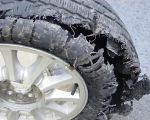How to Use a Tire Sealant for Flat Tires: A Comprehensive Guide
Anyone who’s ever experienced a flat tire knows how frustrating it can be, especially if you’re in the middle of a long drive or stranded in an inconvenient location. There’s no denying the sinking feeling you get when you realize that your tire has deflated, and it’s often followed by the question: “What now?” For years, I’ve been carrying a spare tire in my trunk as a backup, but when I discovered tire sealants, I realized there was an even more convenient and quick way to handle a flat tire. Tire sealants, often sold in a can, provide a fast, temporary solution to a flat tire, allowing you to get back on the road without the need for a complete tire replacement right away.
In this article, I’ll walk you through everything you need to know about using tire sealants to fix a flat tire. Whether you’re a seasoned car owner or a first-time user of tire sealants, this guide will help you understand the proper steps, potential issues, and best practices for using tire sealant effectively. I’ll also share my personal experience with tire sealants and how they’ve helped me avoid unnecessary delays on the road.

MR. TIRE INC.
2078 New York Ave, Huntington Station, NY 11746, USA
1. What is a Tire Sealant and How Does It Work?
Before diving into how to use a tire sealant, it’s important to understand what it is and how it works. A tire sealant is a liquid product designed to temporarily repair punctures in tires. Typically, tire sealants come in spray cans or bottles and are meant to be injected into the tire through the valve stem. Once inside, the sealant coats the inner surface of the tire and seals any small holes or punctures, allowing you to continue driving for a short period of time.
I first used a tire sealant during a road trip when I encountered a small puncture from a nail. At first, I wasn’t sure how it would work, but after following the instructions, I was amazed at how quickly it sealed the hole. The tire was instantly inflated, and I was able to drive to the nearest repair shop without further damage. Sealants are especially useful when you’re far from a mechanic or in a location where changing the tire isn’t feasible.
The key benefit of using tire sealant is that it’s quick and easy. It allows you to seal up small punctures and temporarily inflate the tire, giving you enough time to get to a repair shop. However, it’s important to note that tire sealants are intended for temporary use and are not a permanent solution. If your tire has a large puncture or significant damage, you’ll still need to replace or repair the tire at a professional service center.

MR. TIRE INC.
2078 New York Ave, Huntington Station, NY 11746, USA
2. Types of Tire Sealants: Choosing the Right One for Your Needs
There are several types of tire sealants available on the market, each with its own unique formulation and purpose. It’s essential to choose the right type of sealant based on the size and nature of the puncture, as well as the specific needs of your vehicle. After using different types of tire sealants over the years, I’ve learned which ones work best in various situations.
The most common types of tire sealants include:
- Latex-Based Sealants: These are the most commonly used and work by creating a flexible plug inside the tire. They’re great for sealing small punctures, such as those caused by nails or screws. I’ve used latex-based sealants many times for minor punctures, and they tend to be effective and easy to apply.
- Non-Latex Sealants: These sealants are made from materials other than latex, such as polyurethane, and are designed to be more durable. They work well for larger punctures and can withstand higher temperatures. While I’ve used non-latex sealants for larger repairs, they tend to be a little more difficult to apply and may require more effort to clean up.
- Foam Sealants: Foam sealants are typically used for larger punctures or in cases where the tire has lost a significant amount of air. These sealants work by inflating the tire and filling the cavity with foam that forms a temporary seal. I’ve found foam sealants to be effective for tires with larger punctures, but they can be messier than other types.
For most everyday car owners, latex-based sealants are often the best choice due to their affordability, ease of use, and ability to seal smaller punctures effectively. However, if you’re dealing with a larger hole or more serious damage, non-latex or foam sealants may be better suited for the job.
3. Step-by-Step Guide to Using a Tire Sealant
Once you’ve chosen the appropriate tire sealant, the next step is to use it. Here’s the step-by-step process I follow to apply tire sealant and get my car back on the road as quickly as possible:
- Step 1: Safety First - Before starting, make sure you’re in a safe location, such as a parking lot or the shoulder of the road. If you’re on a busy road, it’s essential to park as far away from traffic as possible to avoid any accidents. Turn on your hazard lights to alert other drivers of your situation.
- Step 2: Inspect the Tire - Before applying the sealant, visually inspect the tire to locate the puncture. If you’re not sure where the hole is, you can use soapy water to check for bubbles that indicate escaping air. Once you’ve identified the puncture, you’re ready to apply the sealant.
- Step 3: Attach the Sealant Can - Remove the valve stem cap from the affected tire and attach the nozzle of the sealant can to the valve stem. Make sure it’s securely attached to avoid any leakage. Most cans will come with instructions on how much sealant to apply based on the size of your tire.
- Step 4: Inject the Sealant - Press down on the can to inject the sealant into the tire. Some sealants will inflate the tire as they’re applied, while others require you to inflate the tire separately. Once the sealant is inside, allow it to spread throughout the tire, sealing the puncture.
- Step 5: Check the Tire Pressure - After applying the sealant, check the tire pressure using a gauge. If the tire is still underinflated, use a portable air compressor to top it off. Make sure the tire is inflated to the recommended pressure before driving.
- Step 6: Drive and Distribute the Sealant - Drive your car for a few minutes to allow the sealant to fully distribute inside the tire. This helps ensure that the puncture is completely sealed. Be cautious while driving, as the repair is temporary and you should drive at a moderate speed until you can reach a repair shop.
In my experience, using a tire sealant is quick and efficient, especially if you’re in a pinch. However, it’s important to remember that this is a temporary fix, and you should have the tire inspected and repaired by a professional as soon as possible.
4. When to Seek Professional Help
While tire sealants are a great temporary solution, they’re not meant to be a permanent fix. There are times when you should seek professional help. If the tire has a large puncture, significant damage, or if the sealant doesn’t seem to work, it’s time to call a towing service or take the car to a repair shop.
I’ve had instances where the sealant didn’t completely seal the hole, and in these cases, I had to rely on a towing company like Rescue & Towing to transport my vehicle to a nearby shop. Their prompt service and ability to handle emergency situations like this have been invaluable in getting my car repaired quickly.
5. Preventing Future Tire Issues
To avoid future flat tire problems, it’s important to regularly check your tires for signs of wear, punctures, or damage. I’ve found that keeping my tires properly inflated and performing routine tire checks can significantly reduce the risk of a flat. Additionally, using high-quality tire sealants when necessary can provide peace of mind in case of an emergency.
If you’re looking for additional assistance or need a reliable towing service, I recommend reaching out to Rescue & Towing. They offer professional services for all types of emergency situations, including flat tire fixes, and can provide quick help when you need it most.


























